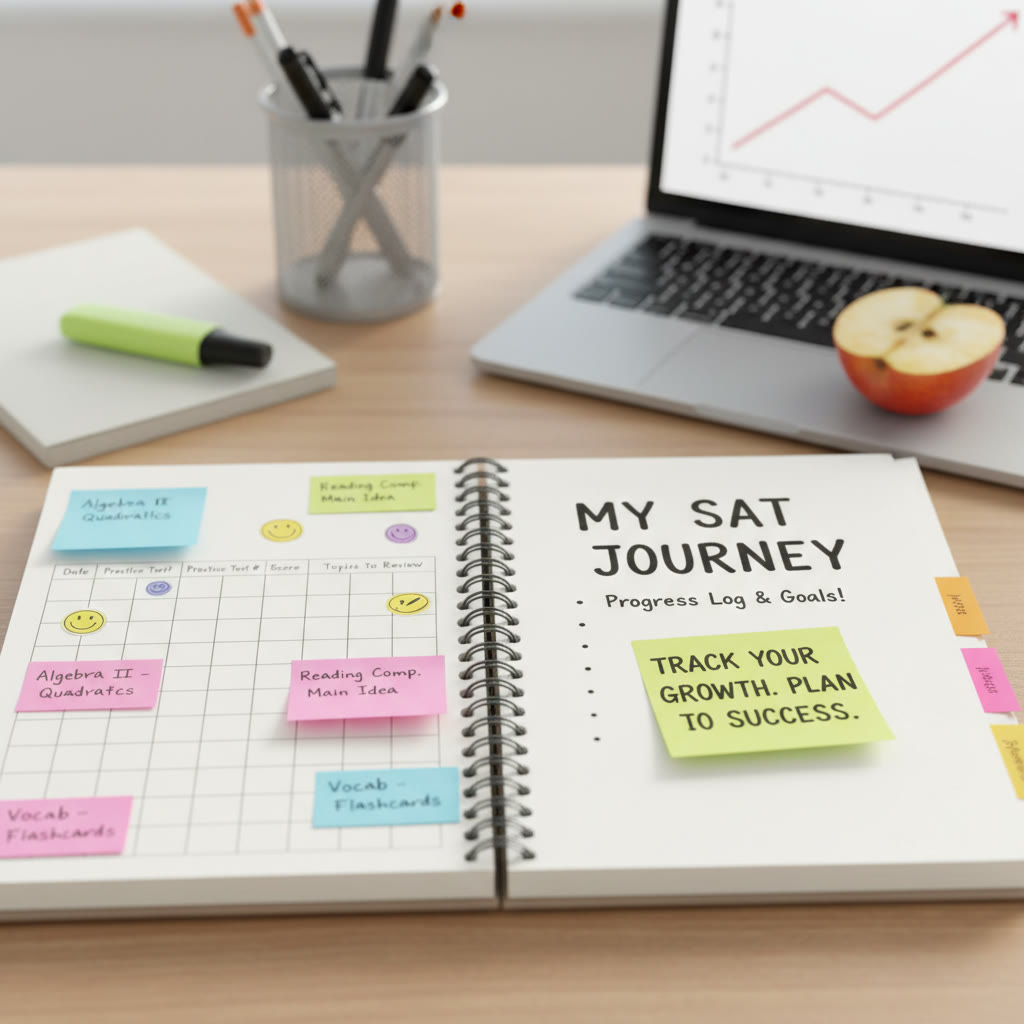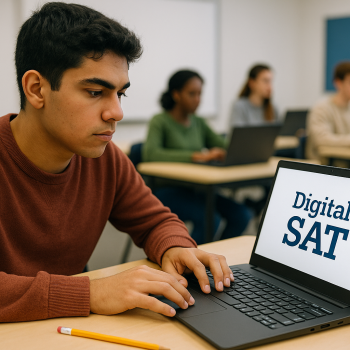The Hidden Cost of Comparing SAT Scores With Friends
We’ve all been there: a casual text thread where someone drops a score, the little double-tick of read receipts, and suddenly your day tilts. Whether your phone buzzes with a 1520 or a 1020, comparing SAT scores with friends is an emotional quicksand — the numbers seem simple, but the fallout is complicated. This blog is for students who want to understand what they’re really paying when they measure themselves against peers, and for anyone who wants a kinder, smarter way to prepare.
Why a Number Feels Like a Verdict
First, let’s be honest about why SAT scores carry so much weight. Colleges use them as a standardized snapshot of readiness. Scholarships and class placement sometimes hinge on them. Parents, counselors, and peers discuss them like they’re the final score of a life decision. But a single numerical snapshot can’t capture progress, potential, or how well a student will actually perform in college.
When you compare scores publicly — in hallways, group chats, or social media — the number becomes social currency. It’s not just a measure of academic skill; it’s a proxy for worth, intelligence, and future success in the eyes of others. That’s a heavy burden to put on anything, let alone a timed exam.
Emotional Costs: Confidence, Motivation, and Identity
Comparative thinking affects the brain. It triggers the same neural circuitry that responds to reward and threat. If friends celebrate a higher score, your brain can read that as social reward being taken away — which, over time, erodes confidence.
- Confidence erosion: Repeated comparisons can make incremental progress feel invisible. A 30-point improvement might be huge personally, but if someone else posts a 200-point gain, yours can feel trivial.
- Motivation misfires: When your focus shifts from mastery to social ranking, study plans become performative. You might chase quick wins for the sake of bragging rights instead of building durable skills.
- Fixed identity traps: If you start labeling yourself (“I’m not a math person” or “I’m the humanities kid”), you limit growth. Those labels can become self-fulfilling prophecies.
Academic Costs: Bad Strategies and Lost Focus
Beyond feelings, comparing scores changes behavior. Students who fixate on a friend’s number are more likely to adopt reactive strategies:
- Studying what’s flashy instead of what’s necessary (e.g., memorizing tips for rare problem types rather than strengthening fundamentals).
- Switching practice plans midstream because someone else tried a different method and posted quick gains.
- Prioritizing practice tests as scoreboard opportunities rather than learning tools to diagnose and close gaps.
These shifts interrupt the feedback loop that actually leads to improvement: diagnose → targeted practice → review → repeat. When the loop is broken, time spent studying yields diminishing returns.
Social Costs: Friendships, Pressure, and Isolation
Score comparisons can change how friendships feel. Some relationships grow competitive in unhealthy ways; others cool because students retreat from group settings to avoid judgment. The consequence is twofold:
- Lost support: Study groups can be incredible resources — and they stop working when people hide weaknesses to protect social standing.
- Increased isolation: Students may withdraw to avoid comparison, missing out on collaborative learning and emotional support.
Opportunity Cost: What Time and Energy Really Cost You
Every hour spent stewing about a friend’s score is an hour not spent improving your own. Opportunity cost isn’t just academic — it’s emotional and practical. It shows up as:
- Time wasted refreshing social feeds instead of practicing weaknesses.
- Mental energy drained by anxiety, reducing the quality of study sessions.
- Misallocated study tactics that lead to fast, shallow gains rather than consistent growth.
Think of your study time as an investment. Comparing makes you chase the wrong dividends.
Practical Reality: What SAT Scores Actually Measure
To ground this conversation, remember what the SAT is: a standardized test scored from 400–1600, with two main sections — Evidence-Based Reading and Writing (EBRW) and Math — each scored 200–800. The test is a snapshot of your performance on a particular day under timed conditions. Important context:
- Performance can vary day-to-day. Sleep, stress, and test-taking conditions matter.
- Improvement often comes from targeted practice, not just taking more full-length tests.
- Colleges look at trends and context — a single number rarely tells the whole story.
Quick Table: Score Bands and What They Often Mean (Approximate)
| Score Range | What It Often Suggests | Helpful Focus |
|---|---|---|
| 400–900 | Below average; clear room for strategic gains | Foundations in algebra/grammar, time management, guided practice |
| 900–1100 | Near average; good baseline, targeted improvements pay off | Master core concepts, practice pacing, diagnostic reviews |
| 1100–1300 | Above average; competitive for many schools | Refine weaknesses, advanced problem strategies, accuracy under time |
| 1300–1450 | Strong; attracts more selective options | Fine-tune strategy, high-difficulty practice, question triage |
| 1450–1600 | Top tier; demonstrates mastery and consistency | Polish, error analysis, elite-level question types |
These bands are simplified and approximate. Colleges consider many non-test factors, and individual goals vary. What matters most is where you started and how you’re moving forward.
Why Social Comparison Is a Poor Benchmark
Friends’ scores are odd benchmarks for three main reasons:
- Different baselines: Your friend’s academic background, school curriculum, and test-taking history influence their starting point.
- Different goals: A 1300 might be life-changing for one student and just a step toward an elite program for another.
- Different resources: Access to tutoring, study materials, and time can skew comparisons.
Put simply: apples-with-oranges. When you compare, you run the risk of measuring against an irrelevant yardstick.
Stories That Illustrate the Cost
Consider two students, Maya and Cole.
- Maya posts her 1440 proudly. Cole sees it and spirals. He previously made steady progress from 980 to 1150 but now compares himself and abandons the slow, effective method he was using for a trendy crash-course that promises 200-point gains in a weekend. The crash-course gives him a small bump but leaves gaps. His final score stagnates because he lost momentum and depth.
- Cole’s friend Priya keeps her practice logs in a group chat, and the group celebrates consistent weekly progress: +20 consolidation, +15 vocabulary, targeted math drills. Her quiet, steady grind produces a large gain over months. Priya’s approach shows that slow, targeted work compounds — but that story rarely gets the same social applause as a single flashy score drop.
Which approach would you bet on? The quick spectacle or the steady compounder?
Switching Lanes: Healthy Alternatives to Comparison
Replace “How did you do?” with questions that invite growth. Try asking:
- “What was the hardest question type for you?”
- “What’s one thing you learned from your latest practice test?”
- “What’s your targeted study focus this week?”
These questions promote reflection, not ranking. They turn social interaction into shared problem-solving — and that’s where progress happens.
Actionable Plan: Move From Comparison to Calibration
If you’re ready to shift, here’s a 6-step approach to turn social pressure into productive energy:
- 1. Set personal benchmarks: Instead of a friend’s number, set milestones based on your diagnostic test. For example: reduce careless errors by 50% in one month; master geometry formulas; move from 500 to 620 in Math.
- 2. Diagnose, don’t copy: Use practice tests to identify patterns — not to measure up against others. Track where you lose points: timing, specific content, or careless mistakes.
- 3. Build a targeted plan: Each week, pick one content weakness and one test-taking skill to sharpen. That preserves focus and avoids scattershot studying.
- 4. Use accountability wisely: Share progress with a mentor or tutor who gives constructive feedback instead of social approval.
- 5. Celebrate improvements: Recognize micro-wins like shaving 10 minutes off a section or correcting a recurring mistake.
- 6. Reframe failure: Treat wrong answers as data not drama. Each mistake points to an opportunity to learn.
Sample 6-Week Study Cycle (Targeted and Realistic)
This example balances content, skill-building, and full-length practice tests. Adapt it to your starting score and time constraints.
- Week 1: Diagnostic test. Identify top three weaknesses. Build a study plan with targeted drills (daily 60–90 minutes).
- Week 2: Focus on core content (e.g., algebra foundations) + timed practice on those topics. One full-length practice on weekend.
- Week 3: Introduce advanced problem types relevant to your section (e.g., data analysis or complex sentence structure). Review errors in depth.
- Week 4: Practice pacing strategies. Simulate test-day conditions twice. Adjust strategies based on performance.
- Week 5: Fine-tune high-yield strategies: question triage, calculator use, and elimination techniques. Focus on endurance.
- Week 6: Light review, confidence-building, and final full-length test. Rest and prep logistics for test day.
How Tutoring and Feedback Fit In
Personalized coaching can transform this process. One-on-one guidance helps you interpret diagnostic data, build a realistic routine, and stay accountable without the emotional noise of social comparison. Sparkl’s personalized tutoring offers tailored study plans, expert tutors, and AI-driven insights to help students focus on what matters for them — not what looks best in a group chat. A tutor can point out subtle patterns (like a repeated algebraic setup error) that are easy to miss on your own.
Practical Tips for Test Day to Avoid Comparison Pitfalls
On test day, social dynamics are strong. Friends will ask, compare, or display nerves. Here’s how to keep centered:
- Arrive early. Use the time to review light notes or breathe — not to compare warm-up scores.
- Avoid score talk before or immediately after testing. Conversations in the parking lot can spiral into unproductive emotional comparisons.
- Journal one thing you did well and one specific improvement to make next time. This keeps focus internal and growth-oriented.

When Comparison Is Useful — and How to Make It Healthy
Not all comparison is bad. Social benchmarks can inspire and provide useful study strategies — but the difference is purpose. Healthy comparison is:
- Specific: You compare methods, not worth.
- Constructive: You ask how someone practiced a weak area rather than just noting their score.
- Temporary: You use it to learn a tactic, then return to your plan.
For example, if a friend explains how they cut careless errors by marking problem types, that’s actionable. If they only post a screenshot of a score without context, it’s less useful.
Measuring Progress in Ways That Matter
Beyond raw scores, track metrics that predict long-term improvement:
- Accuracy on targeted question types (e.g., percent correct on geometry problems).
- Timing improvement (minutes saved per section while maintaining accuracy).
- Stability of scores across multiple practice tests (reduces noise).
- Qualitative wins: clarity on why mistakes happen, strategies learned, confidence in managing time.
These indicators are more meaningful than a single score snapshot in a group chat.
How Parents and Teachers Can Help
Adults who support students can do a lot to reduce harmful comparison:
- Encourage process-focused praise: celebrate consistent effort and strategy, not just final numbers.
- Create confidential feedback channels: students may open up more in one-on-one conversations rather than public groups.
- Recommend resources that personalize learning. For example, tutoring that tailors plans to individual gaps — like Sparkl’s personalized tutoring with expert tutors and AI-driven insights — can redirect energy from public comparison to private growth.
A Final Real-World Comparison: Training for a Race vs. Posting Finish Times
Imagine training for a 10k. If you only post your finish time once and obsess over friends’ times, you miss the point of training: improving endurance, technique, and consistency. The athlete who keeps a log, tracks splits, and adjusts training based on data will probably make the bigger leap. SAT prep is the same. Share tactics, celebrate steady improvements, and treat social media posts like highlight reels — not the whole story.

Putting It All Together: A Short Checklist to Stop Wasting Energy
- Delete or mute score-based threads if they harm your mood.
- Set three personal goals tied to diagnostics (content + skill + timing).
- Use practice tests as diagnostics, not as status updates.
- Seek one-on-one feedback from a coach or tutor you trust.
- Celebrate micro-wins and reframe mistakes as data.
Closing Thoughts: Your Score Is a Tool, Not an Identity
Comparing SAT scores with friends is an easy trap because it satisfies curiosity and social belonging in the short term. But over weeks and months, it can cost you confidence, focus, and progress. The antidote is simple in idea though not always easy in practice: measure what matters to you, build a targeted plan, and get feedback from mentors who prioritize your growth. Tools like Sparkl’s personalized tutoring — which offers tailored study plans, 1-on-1 guidance, expert tutors, and AI-driven insights — can help you turn anxiety into strategy and comparisons into learning opportunities.
Remember: the best measure of success is improvement — not someone else’s highlight reel. Treat your SAT journey like training for a race: keep a log, follow a plan, get coaching, and focus on beating yesterday’s version of yourself. That’s the kind of score that lasts.
Parting Prompt
Before you check another friend’s score, ask yourself: “What am I going to do with this information?” If the answer is anything other than “learn something useful” or “support a friend,” consider closing the app and doing one focused practice set instead. Your future self will thank you.













No Comments
Leave a comment Cancel